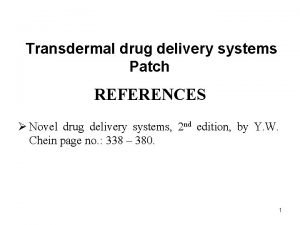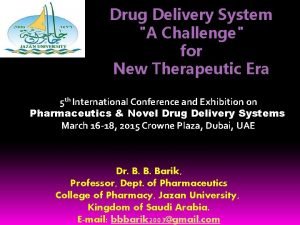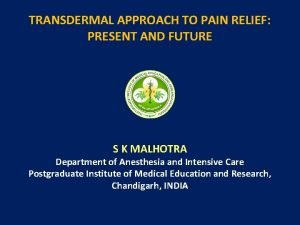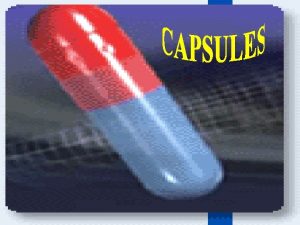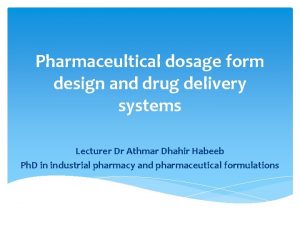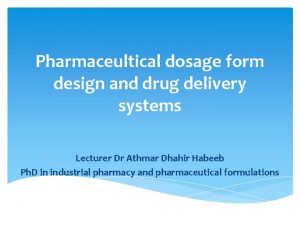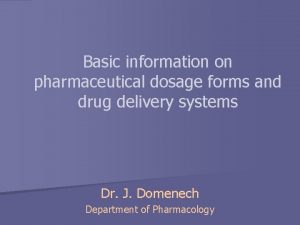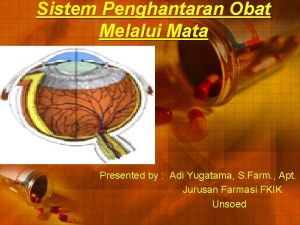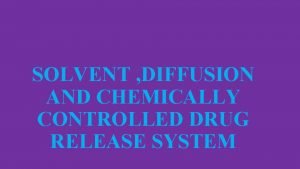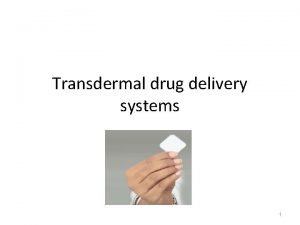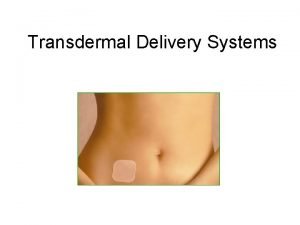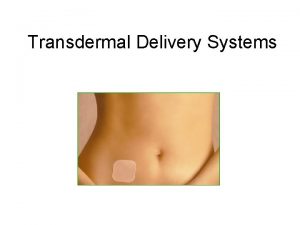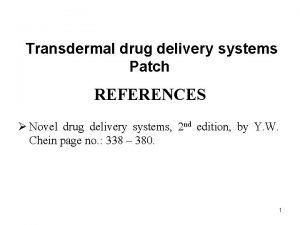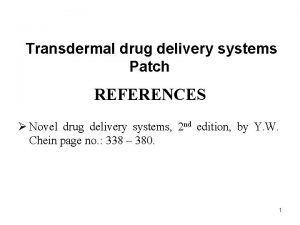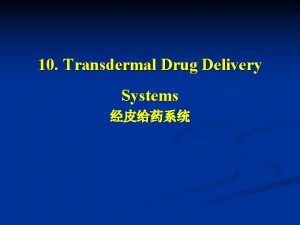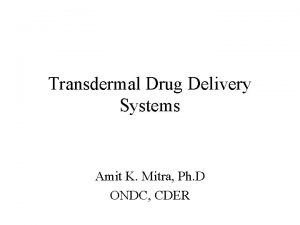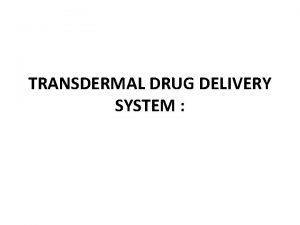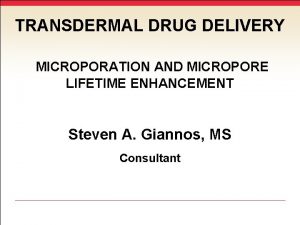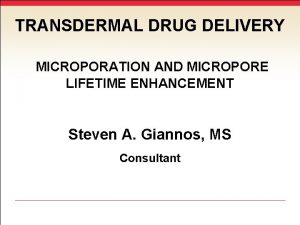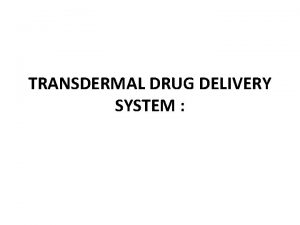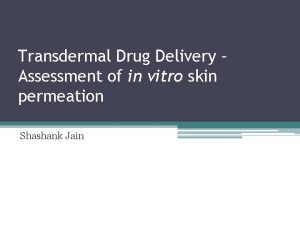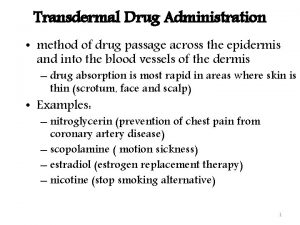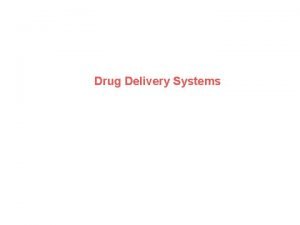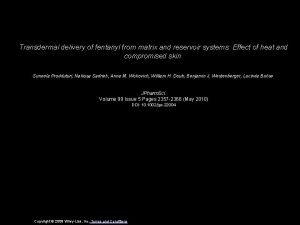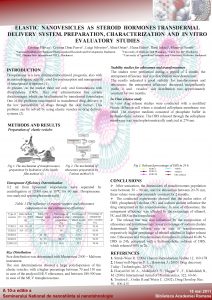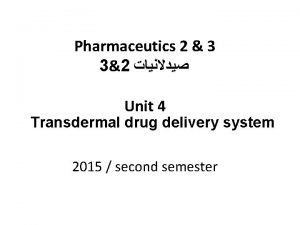NOVEL DRUG DELIVERY SYSTEMS Introduction Transdermal drug delivery




















- Slides: 20

NOVEL DRUG DELIVERY SYSTEMS

Introduction Transdermal drug delivery systems – These are defined as self-contained, discrete dosage forms which when applied to the intact skin, deliver the drug(s) through the skin at a controlled rate to the systemic circulation. Advantages üTransdermal medication delivers a steady infusion of a drug over an extended period of time. Adverse effects or therapeutic failures frequently associated with intermittent dosing can also be avoided. üTransdermal delivery can increase therapeutic value of many drugs by avoiding specific problems associated with the drug (ex- GIT irritation, low absorption, decomposition due to hepatic first pass effect, formation of metabolites that causes side effects, short half life necessitating frequent dosing etc). üSelf administration is possible with these systems. üThe drug input can be terminated at any point of time by removing transdermal patch.

Transdermal drug delivery systems Dis advantages – • The drug must have some desirable physicochemical properties for penetration through stratum conium & if the drug dosage required for therapeutic value is more than 10 mg/day, the transdermal delivery will be difficult for administration. Daily doses of less than 5 mg/day is preferred. • Skin irritation or contact dermatitis due to drug, excipients and enhancers of drug used to increase percutaneous absorption is another limitation. • Clinical need is another area that has to be examined carefully before a decision is made to develop a transdermal product. • The barrier function of skin changes from one site to another on the same person, from person to person & with age.

Kinetics of transdermal penetration Knowledge of skin permeation kinetics is vital to the successful development of transdermal therapeutic systems. Transdermal permeation of drug involves the following steps a) Sorption by stratum corneum b) Penetration of drug through viable epidermis c) Uptake of the drug by capillary network in the dermal papillary layer Basic components of transdermal drug delivery systems 1) Polymer matrix/matrices: Natural polymers – Cellulose, gelatin, starches. b) Synthetic elastomers – polybutadiene, polysiloxane, neoprene etc. c) Synthetic polymers – PVC, PVA, polyethylene, polyurea. 2) Drugs 3) Permeation enhancers – These are compound which promote skin permeability by altering the skin as a barrier to the flux of a desired penetrant. A large no of compounds are identified as solvents, surfactants, binary systems & miscellanous chemicals. 4) Other excipients – It includes adhesives, backing membrane.

Approaches used in development of transdermal systems • Membrane permeation controlled systems – Nitroglycerin releasing transdermal system, clonidine releasing transdermal system. • Adhesive dispersion systems – Isosorbide dinitrate releasing transdermal system • Matrix diffusion controlled – Nitro-Dur-I, Nitro-Dur-II • Microreservoir / Microsealed dissolution controlled systems Nitrodisc (nitroglycerine releasing transdermal systems).

Ocular drug delivery systems The objective of the ocular drug delivery is to a) b) c) Improve ocular contact time Enhancing corneal permeability Enhancing site specificity Role of polymers in ocular drug delivery Incorporation of polymers into an aqueous medium of drug could increase solution viscosity and reduces the solution drainage. Increasing the solution viscosity of pilocarpine from 1 to 100 cps by using methyl cellulose reduced the drug drainage and 2 fold increase in drug concentration in aqueous humor was obtained. Natural polymers such as sodium hyaluronate & chondroitin sulfate are being investigated as viscosity inducing agents. Ophthalmic inserts – It offers the potential advantage of improving patient compliance by reducing dosing frequency. The desired criteria for a controlled release ocular insert are a) Comfort b) Ease of handling c) sterility d) Ease of manufacture. Controlled release systems for ocular use encompass both erodible & nonerodible systems. The non-erodible inserts are of 2 types a) b) Ocusert system Contact lens

Ocular drug delivery systems Ocusert systems – It is preprogrammed to release pilocarpine at constant rate of 20 or 40 μg/hr around the clock for 7 days for the treatment of glaucoma. Contact Lens – Therapeutic soft lenses are often used to aid corneal wound healing in patients with infection, corneal ulcers characterised by thining of cornea. Erodible Inserts – Several erodible drug inserts have been prepared & tested for ocular use. Pilocarpine containing CMC wafers, PVA disc or rod is a classical example. The three devices of erodible inserts have been marketed to date are a) The Lacriserts b) SODI (soluble ocular drug insert) c) Minidisc. Corneal collagen shields – Collagen is a protein that can be safely applied to the body and is used to promote wound healing and delivers a variety of medications to the cornea & ocular tissues. A study published in 1978 showed that wafer shaped collagen inserts impregnated with gentamicin produced highest level of drug in tear film & tissue in the rabbit eye compared to drops, ointment & conjuctival injection.

Buccal drug delivery systems • Drugs administered to the oral cavity are removed from the site of administration by natural clearance mechanisms. • For drug delivery purposes, the term bioadhesion implies attachment of a drug carrier system at a specific biological action. In most instances the bioadhesive polymer is in contact with the mucous & hence the term mucoadhesion is employed. Buccal mucosa – The buccal cavity provides a highly vascular mucous membrane site for administration of drugs. • The epithelial lining of oral cavity differs both in type (keratinised & nonkeratinised) & thickness in different areas & the differences give rise to regional variations in permeability to drugs. • The buccal mucosa is being perceived as an alternative for peptide & protein drug administration especially when sustained delivery is desired. • The future challenge in the development of buccoadhesive dosage forms is to modify the permeability barrier of the mucosa using safe and effective penetration enhancers.

Buccal drug delivery systems Mucoadhesive buccal dosage forms have 3 desirable features. • They are readily localised in the oral cavity to improve & enhance the bioavailability of drugs. • They facilitate intimate contact of the formulation with the underlying absorption surface. • They also prolong residence time of the dosage form to permit once or twice a day dosing. Methods to study bioadhesion • Study of cellular modifications during interpretation • Study of adhesion on artificial media • Study of adhesion on biological tissues Factors affecting bioadhesion • The bioadhesive polymer & environment both affect bioadhesion. The polymer related factors include mol. wt, polymer chain length & configuration, concentration of active polymer & swelling. • The environment related factors are p. H & applied strength.

Liposomes as drug carriers ü These are simple microscopic (lipid) vesicles in which an aqueous volume is entirely enclosed by a membrane composed of lipid molecule. ü The drug molecules can either be encapsulated in aqueous space or intercalated into the lipid bilayer. ü Amphipathic molecules are used to form Liposomes. Some examples of amphipathic molecules are lecithin, phosphatidyl glycerol etc. ü The exact location of drug will depend upon it’s physicochemical characteristics & the composition of lipids. ü A standard composition of Liposome is egg lecithin : cholesterol : phosphatidyl glycerol in molar ratio (0. 9 : 1. 0 : 0. 1). These lipids can be stored either as solids, or inorganic solution at -20 or -70ºC in order to reduce the chances of oxidation. Method of preparation of Liposomes – It involves 3 or 4 basic stages a) Drying down lipids from organic solvent b) Dispersion of lipids in aqueous media c) Purification of resultant Liposomes d) Analysis of final product

Liposomes as drug carriers Characterisation of Liposomes • The behaviour of Liposomes in both physical & biological systems is governed by the factors such as physical size, membrane permeability, % entrapped solutes, chemical composition as well as quantity & purity of starting materials. • Therefore the Liposomes are characterised for physical attributes (shape, size & it’s distribution, % drug captured, entrapped volume, lamellarity, % drug release and chemical composition (estimation of phospholipids, cholesterol). Applications of Liposomes • Liposomes prove to be efficient carrier for targeting the drug to site of action, because of being biodegradable & identical to biological membrane. • Liposomes can able to produce localised drug effect, enhanced drug uptake & cell Liposome interaction. • Liposomes are carriers for vaccines, antigens, micromolecules for site specific delivery (oral, topical, pulmonary & ophthalmic etc).

Niosomes as drug carriers • Niosomes are non-ionic surfactant vesicles that can entrap both hydrophilic and lipophilic drugs either in aqueous layer or in vesicular membrane made of lipid materials. Niosomes can prolong the circulation of entrapped drugs. • Some examples of non-ionic surfactants like span-40, 60, 80 & tweens are commonly used. These surfactants can be combined with cholesterol to entrap drugs in vesicles. Formulation of Niosomes – It can be formulated by lipid layer hydration method, reverse phase evaporation techniques or by trans membrane p. H gradient uptake process. Characterisation – Niosomes can be characterised by size distribution studies (small niosomes: 100 -200 nm, large: 800 -900 nm, big: 2 -4 μm). Evaluation – Drug entrapment efficiency, drug stability, drug leakage in saline & plasma on storage, PK aspects, toxicity studies & drug targeting efficiency.

Niosomes as drug carriers Loading of drug(s) into Niosomes – The use of niosomes as drug delivery vehicles naturally assumes an ability to efficiently load the niosomes with the drug of choice. Passive trapping and active trapping are 2 methods used to load drug(s) into niosomes. Benefits of Niosomal drug carrier • Niosomes are more suitable for parenteral drug delivery. • As compared to liposomes, about 50% of phospholipids can be replaced with non-ionic surfactant & the vesicle stability may be improved. • Due to presence of non-ionic surfactants, there may be improvement in permeation & release of drugs entrapped through various barriers of body & organs which may improve the targeting efficiency of drugs. • The drug targeting efficiency of niosomes may be improved using suitable surface modification with the help of other adjuvants.

Niosomes as drug carriers Applications of Niosomes – • Therapeutic agents like anticancer agents, anti infectives, anti HIV agents, antivirals, anti-inflammatory drugs can be entrapped in niosomes to achieve better bioavailability & targeting properties & for reducing the toxicity & side effects of drugs. • Niosomes can be transported by macrophages which are known to infiltrate tumour cells.

Microspheres as drug carriers Microspheres of biodegradable & non biodegradable polymers have been investigated for sustained release depending on the final application. The most important characteristic of microsphere is microphase separation morphology which endows it with a controllable variability in degradation rate & also drug release. Preparation of Microspheres – The preparation of microspheres from natural polymers involves 3 steps a) b) c) In the 1 st step, the solution of polymer is dispersed in a continuous medium such as vegetable oil or an organic solvent using suitable stabilising agent. Dispersion is accomplished using mechanical stirring or by ultrasonication or by high speed homogenisation depending on particle size required. The 2 nd step involves hardening of polymer droplets either by heat denaturation or by chemical cross linking using suitable cross linking agent. The 3 rd step involves separation of solid microspheres, purification & drying.

Microspheres as drug carriers • Drugs are incorporated into the microspheres either during their synthesis or after the microsphere is formed. • High loading can be achieved by insitu loading if drug is insoluble in the dispersion medium employed for microsphere stabilisation. • Washing the microspheres after their preparation to remove surfactants, oils and other impurities etc using solvents in which the drug solubility is high may result in poor loading efficiency. Mechanism of drug release from microspheres • Degradation controlled monolithic system • Diffusion controlled reservoir system • Erodable polyagent system

Microspheres as drug carriers Microspheres based on natural polymers • Albumin microspheres • Casein microspheres • Gelatin microspheres • Polysaccharide microspheres Microspheres based on synthetic polymers • Polyester microspheres • Polyanhydride microspheres • Other biodegradable polymers

Nanoparticles as drug carrier • Nanoparticles are sub nanosized colloidal structures composed of synthetic or semisynthetic polymers. • The first reported nanoparticles were based on non biodegradable polymeric systems (polyacrylamide, polymethyl methacrylate & polystyrene etc). • The polymeric nanoparticles can carry drug(s) or proteinaceous substances (antigens). The drugs may be added during preparation of nanoparticles or to the previously prepared nanoparticles. TYPES OF POLYMERS FOR PREPARATION OF NANOPARTICLES Natural polymers – Lectins, albumin, alginate, dextran, chitosan etc. Synthetic polymers – poly lactic acid, poly lactide co glycolide, polymethyl methacrylate, polybutyl cyanoacrylate.

Nanoparticles Preparation of Nanoparticles – 1) Amphiphilic macromolecule cross linking a) Heat cross linking b) Chemical cross linking 2) • • • Polymerisation based methods Polymerisation of monomers insitu Emulsion (micellar) polymerisation Dispersion polymerisation Interfacial condensation Interfacial complexation 3) • • • Polymer precipitation methods Solvent extraction/evaporation Solvent displacement (nanoprecipitation) Salting out

Nanoparticles Novel nanoparticulate systems • Solid Lipid Nanoparticles (SLN), Copolymerised Peptide Nanoparticles • Hydrogel nanoparticles, Nanocrystals & Nanosuspensions • Biomimetic nanoparticles , Magnetic nanoparticles • Nanoparticles coated with antibodies Characterisation of nanoparticles Particle size & size distribution Charge determination, surface hydrophobicity Chemical analysis of surface, carrier-drug interaction, drug stability Release profile, nanoparticle dispersion stability Applications of Nanoparticles 1) Cancer chemotherapy 4) DNA delivery 2) Ocular delivery 5) Oligonucleotide delivery 3) Brain delivery 6) Lymph targeting
 Transdermal drug delivery system
Transdermal drug delivery system New drug delivery system
New drug delivery system Transdermal patch placement chart
Transdermal patch placement chart Transdermal kontraseptif patch
Transdermal kontraseptif patch Transdermal buprenorphine patch
Transdermal buprenorphine patch Transdermal
Transdermal Punch method capsules
Punch method capsules Rate limiting steps in drug absorption
Rate limiting steps in drug absorption Dosage forms and drug delivery systems
Dosage forms and drug delivery systems Chart of dosage form
Chart of dosage form Novel clinical drug trial design
Novel clinical drug trial design Introduction of health care delivery system
Introduction of health care delivery system Exhausted drug
Exhausted drug Characteristics of victorian fiction
Characteristics of victorian fiction Lacrisert adalah
Lacrisert adalah Reservoir system
Reservoir system Adm methodology accenture
Adm methodology accenture Social service delivery system
Social service delivery system Decision support systems and intelligent systems
Decision support systems and intelligent systems Engineering elegant systems: theory of systems engineering
Engineering elegant systems: theory of systems engineering Embedded systems vs cyber physical systems
Embedded systems vs cyber physical systems
